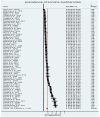Epidemiology of Porcine Cysticercosis in Eastern and Southern Africa: Systematic Review and Meta-Analysis
- PMID: 35372187
- PMCID: PMC8966092
- DOI: 10.3389/fpubh.2022.836177
Epidemiology of Porcine Cysticercosis in Eastern and Southern Africa: Systematic Review and Meta-Analysis
Abstract
Taenia solium cysticercosis is the most common cause of acquired epilepsy in pig-raising and pork-consuming parts of Africa, Latin America, and Asia. This review aimed to systematically compile and synthesize data on the epidemiology of porcine cysticercosis in the Eastern and Southern Africa (ESA) region. Comprehensive searching strategies were employed to retrieve the studies published or reported between January 1,1997 and March 1, 2021, from Pub Med, Hinari, and Google Scholar databases and search platforms. The identified studies that met the inclusion criteria were then appraised for methodological quality. Finally, 44 studies obtained from nine countries were selected and included in this review. Relevant data were extracted using standardized templates for qualitative synthesis and meta-analysis. The overall pooled prevalence estimate of porcine cysticercosis in the ESA region was 17% (95% CI: 14-20%). The prevalence level between and within countries showed high variability. The pooled estimate showed high heterogeneity among the reports (the inverse variance index value (I2) of 98.99%, p < 0.05). The meta-analysis sub-grouped by the type of diagnostic test showed the pooled prevalence estimate of 27% (95% CI: 9-50) by carcass dissection; 23% (95% CI: 14-33) by Antibody-based immunodiagnostic techniques; 23% (95% CI: 18-29) by antigen detecting (Ag)-ELISA, 12% (95% CI: 7-18) by meat inspection, and 9% (95% CI: 7-11) by lingual examination. The meta-analysis sub-grouped by region showed a relatively higher pooled prevalence estimate for the Southern region 22% (95% CI: 15-30) compared to 13% (95% CI: 11-15) in the Eastern region. The highest country-based pooled prevalence was obtained from South Africa (33%, 95% CI: 20-48) and Zambia (22%, 95% CI: 16-29), whereas the lowest pooled prevalence was identified in Madagascar (5%, 95% CI: 4-5) and Rwanda (7%, 95% CI: 6-8). The lack of latrine, traditional pig husbandry practices, unprotected water sources, and increase in age were identified as significant risk factors for the occurrence of porcine cysticercosis in the pooled studies. The findings of this review will provide context-specific input to prioritize the possible intervention programs for T. solium control in the ESA region. More sensitive and specific test-based prevalence estimates, detailed risk factor investigations, and financial losses analysis are needed to establish feasible control strategies.
Systematic review registration: http://www.crd.york.ac.uk/PROSPERO/, identifier: CRD42021238931.
Keywords: Eastern and Southern Africa; epidemiology; meta-analysis; porcine cysticercosis; systematic review.
Copyright © 2022 Gulelat, Eguale, Kebede, Aleme, Fèvre and Cook.
Conflict of interest statement
The authors declare that the research was conducted in the absence of any commercial or financial relationships that could be construed as a potential conflict of interest.
Figures







References
-
- WHO/FAO/OIE . WHO/FAO/OIE Guidelines for the surveillance, prevention, and control of taeniosis/cysticercosis. (2005).
-
- WHO . Working to overcome the global impact of neglected tropical diseases: First WHO report on neglected tropical diseases First WHO report on neglected tropical diseases, Geneva: World Health Organization. (2010).
-
- Kungu JM. MMD Michael Ocaido and Francis Ejobi Status of Taenia solium cysticercosis and predisposing factors in developing countries involved in pig farming. Int J One Health. (2015) 1:6–13. 10.14202/IJOH.2015.6-13 - DOI
-
- Schantz PM, Cruz M, Sarti E, Pawlowski Z. Potential eradicability of taeniasis and cysticercosis bulletin of PAHO. Bull Pan Am Health Organ. (1993) 27:397–403. - PubMed
Publication types
MeSH terms
Grants and funding
LinkOut - more resources
Full Text Sources
Miscellaneous

